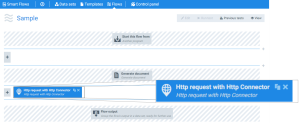HTTP request with HTTP Connector 
The HTTP Request with HTTP connector flow block executes HTTP requests![]() An HTTP request is made by a client, to a named host, which is located on a server. The aim of the request is to access a resource on the server. during your flow.
An HTTP request is made by a client, to a named host, which is located on a server. The aim of the request is to access a resource on the server. during your flow.
For example, you may need to call an external API to send information or start a Power Automate Flow after your Smart Flow has run.
However, suppose you need to call an external API to get data and use that data in the flow, we recommend using the Retrieve data with HTTP Connector on page 1 instead.
The primary use cases for the HTTP request with HTTP Connector flow block are:
-
Sending data to start a process on an external system
-
Retrieving data from an external system
This HTTP request with HTTP Connector flow block is only available if an 'HTTP(s)' type connector has been previously created in the project.
Parameters
The dropdown menus below provide all of the flow block's configuration options with detailed information and recommendations to help you configure your flow block.
You can further customize your flow block's parameters in several ways
-
 Users can use linked fields to map data from your data set(s)
Users can use linked fields to map data from your data set(s) -
 Users can use edit fields to customize the flow block
Users can use edit fields to customize the flow block -
 Using delayed output settings to wait for signatures or file names of completed documents
Using delayed output settings to wait for signatures or file names of completed documents
The Flow Output section serves as a comprehensive summary of the results and outcomes of a particular flow, providing valuable information to the user. Each setting that composes this output information is described in detail below:

HTTP request with HTTP Connector flow output functions
|
Index No. |
Field name |
Description |
|---|---|---|
| 1 |
Target url |
When checked, the system displays the full URL (base path +path) of the targeted data during the flow output step. |
| 2 |
Status code |
When checked, the system displays the status code of the HTTP request during the flow output step. Select here to see a list of all HTTP status codes. |
| 3 |
Status message |
When checked, the system displays a status message for the HTTP request, such as code 202 Accepted |
The HTTP request with HTTP Connector Basic settings defines the connection for the connector and the method for using that connection.
The Body content type and Post body fields only display if the Method value is set to POST.

HTTP request with HTTP Connector Basic settings functions
|
Index No. |
Field name |
Description |
|---|---|---|
| 1 |
HTTP connector |
Defines the HTTP connectors to use for requests. The connector can be HTTP or HTTPS, where the S indicates Secure. The system encrypts the data during the transfer. Using HTTP does not offer secure encryption. |
| 2 |
Path |
Adds to the HTTP connector field value to create the full URL for the HTTP request(EX: https://MyWebSite.com/pathvalue). |
| 3 |
Method |
Sets the HTTP method for the request with the following options: GET, POST, PUT, DELETE. The system uses GET as the default value. For most cases, we recommend using the POST method. For GET method requests, we recommend using the Retrieve data with HTTP Connector on page 1. |
|
4 |
Stop the flow on a failed request |
When checked, the system stops the flow operation if the HTTP request fails. When not checked, the flow continues running even if the HTTP request fails. |
|
5 |
Body content type |
Specifies the type of content the HTTP request provides to the system with the The content type depends on the configuration of the receiving system. |
|
6 |
Post body |
Provides the body layout to send with the request. The value must match the value selected in the Body content type. If some of the elements in the POST body are dynamic(from previous blocks or data sets), we recommend using a linked field to construct the Post body value. See Linked Fields on page 1 |
The HTTP connector requires HTTP request headers to complete the request transaction. However, if you have configured headers at the connector level; you do not need to add them here. Designers can use these settings to additional headers specific for a request occurring only in this flow block within this particular flow.

HTTP Request Headers settings functions
|
Index No. |
Field name |
Description |
|---|---|---|
| 1 |
Header name |
Defines the Header name for HTTP request with the |
| 2 |
Header value |
Determines the header value based on the configuration of the receiving system. |
